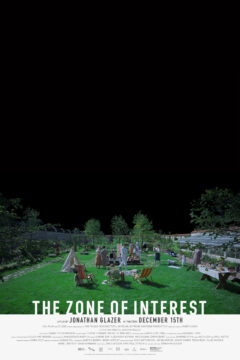Amy Herzog at Film Quarterly:
 Glazer’s decision to only use hidden cameras, without any artificial lighting, creates formal limitations and challenges. But the images retain an intense tactility: patterns on fabrics, the pull of harshly parted and pinned hair, fuzz on a bee that circles a blossom, the softness of a dog’s muzzle, the glint of light reflected from an extracted human tooth. Close-ups punctuate longer observational takes, asserting the specificity of the surfaces that define this moment. The measured pacing of The Zone of Interest strikes me as distinct from the slow cinema tradition, where duration typically serves as a thematic focus. Instead, the length of the shots serves the function of extending the overarching tension. Glazer’s long takes are often paired with an uncomfortable intensity in the soundscape (perhaps the sonic analogue to an uncomfortable close-up), making these moments less an invitation to haptic reverie than an overwhelming of the senses. Suspense, tension, and a nauseating realization about what remains unseen dominate the affect, increased by the long takes that never fully reveal or resolve. The impact feels similar to the way the mind retains a vividly detailed image of a mundane moment preceding a traumatic event that itself can’t be fully recalled.
Glazer’s decision to only use hidden cameras, without any artificial lighting, creates formal limitations and challenges. But the images retain an intense tactility: patterns on fabrics, the pull of harshly parted and pinned hair, fuzz on a bee that circles a blossom, the softness of a dog’s muzzle, the glint of light reflected from an extracted human tooth. Close-ups punctuate longer observational takes, asserting the specificity of the surfaces that define this moment. The measured pacing of The Zone of Interest strikes me as distinct from the slow cinema tradition, where duration typically serves as a thematic focus. Instead, the length of the shots serves the function of extending the overarching tension. Glazer’s long takes are often paired with an uncomfortable intensity in the soundscape (perhaps the sonic analogue to an uncomfortable close-up), making these moments less an invitation to haptic reverie than an overwhelming of the senses. Suspense, tension, and a nauseating realization about what remains unseen dominate the affect, increased by the long takes that never fully reveal or resolve. The impact feels similar to the way the mind retains a vividly detailed image of a mundane moment preceding a traumatic event that itself can’t be fully recalled.
more here.
